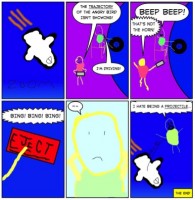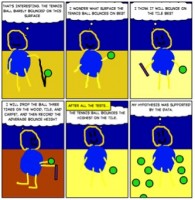Author: Tina Hurlbert (Regional School District 13)
Throughout my 18-year teaching experience currently as a middle school technology teacher and previous in early childhood and elementary education, I have witnessed firsthand, the changes in information availability, accessibility, and sheer volume and how they impact teaching and learning. The way my students researched in the 1990s is dramatically different from the way they research today. The influx of communication channels, increased cultural and linguistic diversity, and globalization of interactions influence today’s students learning environments.
Combine this growth of digital information and communication technologies with an influx of mandates, standardized testing, and packaged programs that ‘guarantee’ student success, and you have before you some very overwhelmed and oversaturated teachers. Smuggling Writing: Strategies that Get Students to Write Every Day in Every Content Area, Grades 3-12, written by Karen Wood, Bruce Taylor, and Katie Stover is a breath of fresh air in our current educational atmosphere. While the title refers mainly to writing, the tools and strategies detailed in this book promote metacognition and scaffolding for teachers and students alike that can be applied to any curricular area. Best of all, these strategies are not merely abstract pontifications; they are concrete, ready-to-implement teaching plans that are steeped in research, standards, and visual supports.
To date, most educational systems, supported by the proliferation of standardized testing in its many forms, are still a one-dimensional universe. Students are expected to decode and read written text in order to learn, and their reading comprehension is measured by ‘close reading activities,’ Degrees of Reading Power (DRP) Assessments, and Fontas and Pinnell literacy assessments. Smuggling Writing is organized to address these concerns in the following ways. The authors address the evolution of Multiliteracies, the implementation of new standards (including Common Core State Standards), and the integration of writing into all content areas.
Smuggling Writing: Strategies that Get Students to Write Every Day in Every Content Area, Grades 3-12 is organized into four main conceptual sections. Each section begins with a scenario or “A Look Inside” narrative of a classroom that is easy to visualize and easy to relate to. Beginning each section this way helps to set the stage for the reader and creates a very practical backdrop against which the strategies are presented later in the section. Following the opening scenario is research-based analysis of the instructional methodology that will follow. The book’s table of contents lists each strategy to be discussed, which makes this very user-friendly. Just choose a topic (i.e. Comprehension), pick a strategy (i.e. Exchange Compare Writing) and flip to that page to begin.
It became clear to me while reading Smuggling Writing that Karen Wood, Bruce Taylor, and Katie Stover are seasoned educators who not only have a firm grasp on content and instruction but also ‘get’ what teachers really need in order to best scaffold and support their students. I was especially interested in Section III Research & Inquiry. A focus on Inquiry Based Learning and Genius Hour in my middle school have brought to the forefront the concept of not only questioning but developing good questions to initiate research. Strategy 24: Inquiry Chart follows the book’s format of including objective, rationale, digital applications, procedures, and – oh my!! – Standards Based Connections. Also included are charts, exemplars, and resources.
This book lends itself to an incredible array of possibilities for practical, immediate, use in the classroom. Technology is embedded into strategies and not treated as a separate entity altogether. Standards are connected. Procedures are outlined. In a time where we educators are treading water in a rocky sea of mandates and data collection, Wood, Taylor, and Stover throw a much-needed lifeline our way.
Wood, K. D., Taylor, B., & Stover, K. (2016). Smuggling Writing: Strategies that Get Students to Write Every Day in Every Content Area, Grades 3-12. Thousand Oaks, CA: Corwin Press.
Tina Hurlbert is a grade 5 and 6 technology teacher in Regional School District 13 in Connecticut. Her work includes teaching students the digital and media literacy skills they need to navigate the ever-changing technologies they are faced with every day, providing them with opportunities to try a variety of technologies and software.


